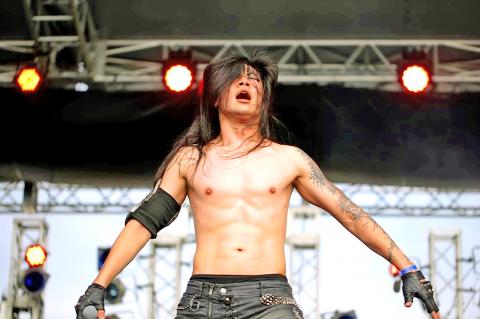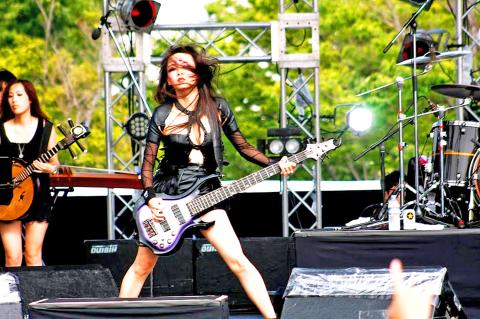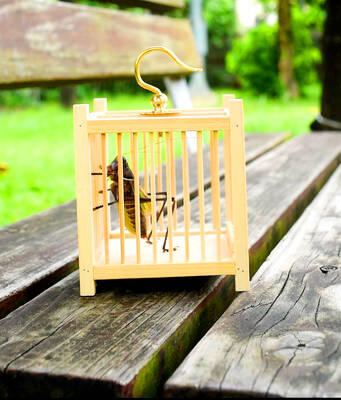As soon as Taiwanese metal band Chthonic returned home after performing in Germany and the Czech Republic in early August, they rushed off to Japan to play at the international Summer Sonic music festival on Aug. 16, making them the first Taiwanese band to perform at all three of Japan’s major music festivals — Fuji Rock, Summer Sonic and Loud Park.
When Chthonic performed at Summer Sonic — one of Asia’s biggest music festivals — on Aug. 16, it was the day after the Japanese Anniversary of the End of World War II. When the band sang the song Takao (Imperial army), they suddenly stopped playing during the chorus, and the entire audience sang as one giant choir in Hoklo (commonly known as Taiwanese) — a stunning scene to see.
Chthonic was the featured Taiwanese act performing on the opening day of the festival. When they went on stage to perform at 5pm, the audience was full of Japanese fans calling out the band members’ names, and the entrance was packed solid. Since it was in the middle of the long Japanese holiday for the Anniversary of the End of World War II, Chthonic chose to perform the songs Broken Jade and Takao from the album Takasago Army.

Photos courtesy of Churi Music Co
照片由出日音樂提供
During the performance the lead singer Freddy said, “We must eliminate war, and not be afraid of the consequences. We must remain brave in our struggle for freedom, justice and equality.” After the performance, the audience kept yelling “encore,” and some fans were screaming “I love you” to the bassist Doris, who generously blew kisses back.
(Liberty Times, Translated by Kyle Jeffcoat)
閃靈八月初才剛結束德國及捷克的演出後凱旋歸國,緊接著十六日參加了日本「夏日音速音樂季」(Summer Sonic),行程滿檔的閃靈成為首支完封日本三大音樂季(Fuji Rock、Summer Sonic、Loud Park)的台灣樂團。

Photos courtesy of Churi Music Co
照片由出日音樂提供
閃靈十六日在亞洲頭號音樂祭Summer Sonic演出,前天是日本終戰紀念日,閃靈唱到「皇軍」(Takao) 時,更刻意突然在副歌部分停止演奏,全場歌迷跟著用台語大合唱,場面相當震撼。
閃靈是Summer Sonic第一天的台灣團壓軸,晚間五點登台前,台下已擠滿日本歌迷,大聲呼喊閃靈及團員名字,把入口處擠得水洩不通,由於當時是日本終戰紀念日連續假期,閃靈也挑選《高砂軍》專輯的「玉碎」及「皇軍」演出。
主唱Freddy說:「我們必須消弭戰爭,但我們也不能因此畏懼,必須勇於爭取自由、正義、平等。」演出結束後,台下仍不斷呼喊安可,還有歌迷向貝斯手Doris狂喊「I love you」,Doris大方回以飛吻。

Photos courtesy of Churi Music Co
照片由出日音樂提供
(自由時報記者陽昕翰)

A: Google has unveiled its 2025 Year in Search chart. No. 10 to No. 6 are: Typhoon Podul, Chinese drama “Love’s Ambition,” tariffs, US President Donald Trump and singer Khalil Fong’s death. B: Wow, actress Rosy Zhao’s new drama is so popular. So what are the top five? A: No. 5 to No. 1 are: Gemini, hanzii.net, NT$10,000 cash handout, entertainer Big S’ death and earthquakes. B: Hasn’t Trump topped this year’s most-searched people chart? A: Yup, and he’s closely followed by cheerleader GuoGuo Chiang at No. 2, whose husband Zack Fanchiang is also at No. 8. Apparently, people are curious about her extramarital

In June, headlines shocked the art world when a visitor damaged a 17th-century painting at the Uffizi Galleries in Florence, Italy, while posing for a photograph. This was not an isolated event. Recently, similar disasters have been reported worldwide, from a child damaging a Mark Rothko painting to a tourist breaking an exhibit by pretending to sit on it. Such incidents highlight why museum etiquette is increasingly crucial. First, we must recognize that art and historical objects are fragile. Once damaged, they may never regain their original condition. Many common actions, though harmless at first glance, can have grave consequences. For

A: Compared to Taiwanese, what did Americans search for most in 2025? B: No. 10 to No. 6 are: Tariffs, FIFA Club World Cup, government shutdown, DeepSeek and incoming New York mayor Zohran Mamdani. A: Mamdani is set to take office on Jan. 1. And what are the top five? B: No. 5 to No. 1 are: the One Big Beautiful Bill Act, iPhone 17, Labubu doll, animated blockbuster KPop Demon Hunters and political activist Charlie Kirk’s assasination. A: The only term to appear on both the Taiwanese and US charts is tariffs. A: 跟台灣人相比,美國人都在搜尋什麼? B: 第10到6名是:關稅、FIFA俱樂部世界盃、政府關閉、DeepSeek語言模型、候任紐約市長佐蘭曼達尼。 A: 曼達尼元旦即將就任,前5名是什麼? B: 第5到1名是:《大而美法案》、iPhone 17、拉布布玩偶、動畫片《KPop獵魔女團》、政治活動家查理柯克遇刺。 A: 看來台、美熱搜榜唯一的共同議題就是--關稅! (By Eddy Chang, Taipei

The world is teeming with danger and unpredictability. To safeguard themselves from harm and invite good fortune, people across cultures carry or display symbolic charms and trinkets. It is common to see beckoning cat figurines in stores in Japan, while people in China have historically kept crickets in cages for good luck. Even flora can serve as emblems of luck, with the four-leaf clover standing out as perhaps the most iconic. A clover is a small plant that typically grows 10 to 30 cms in height. While there are many species of clover, the variety that people consider to